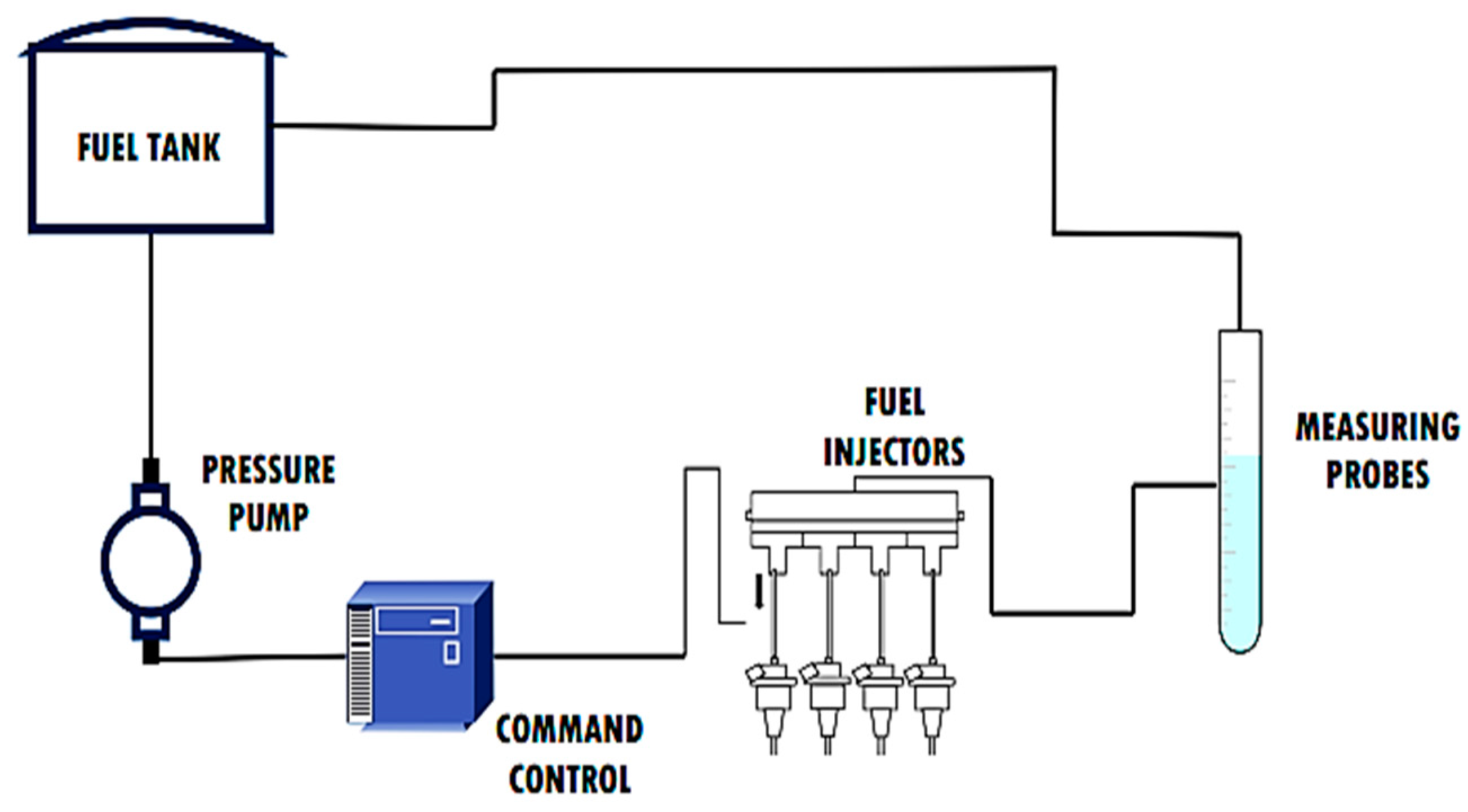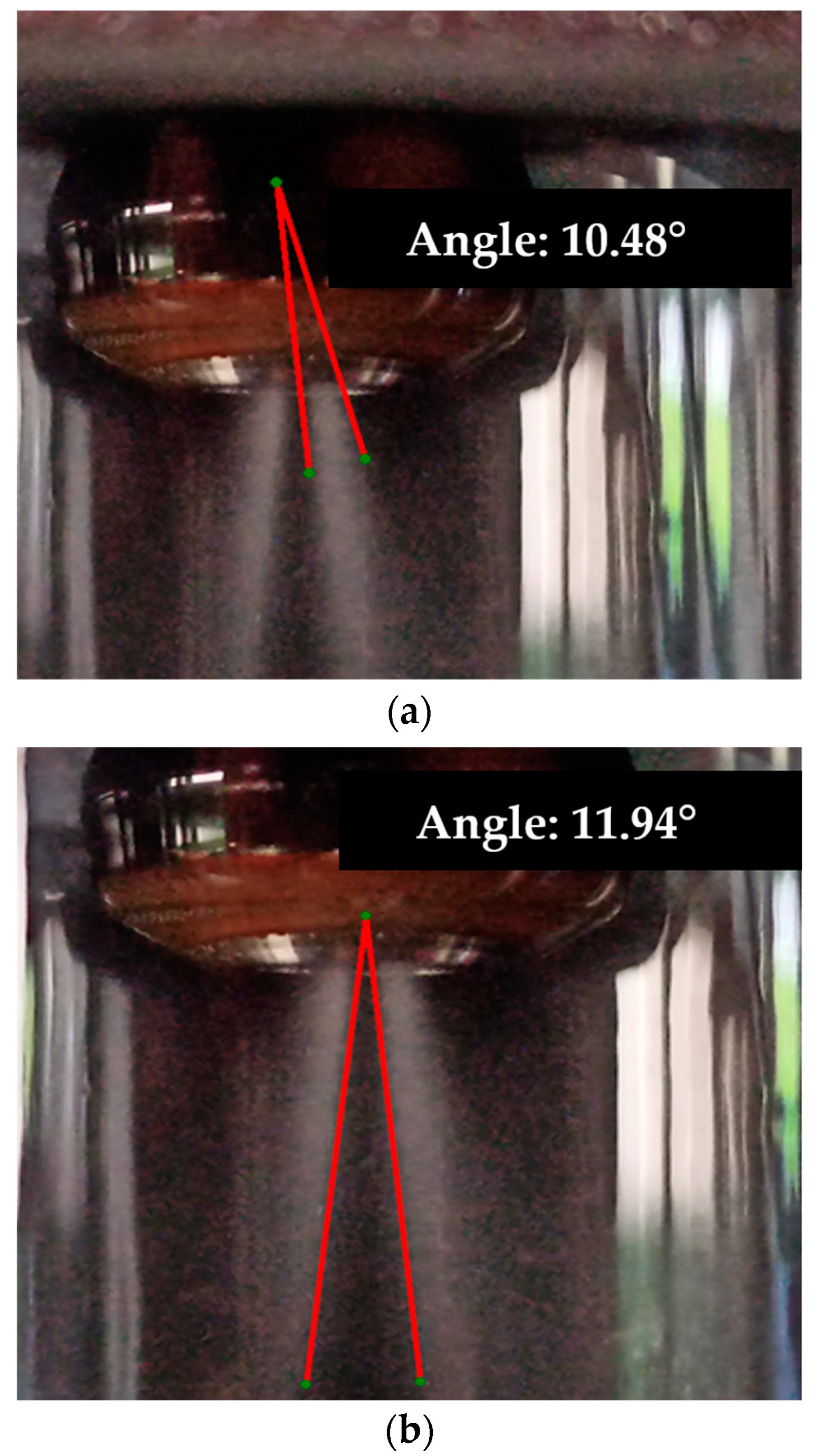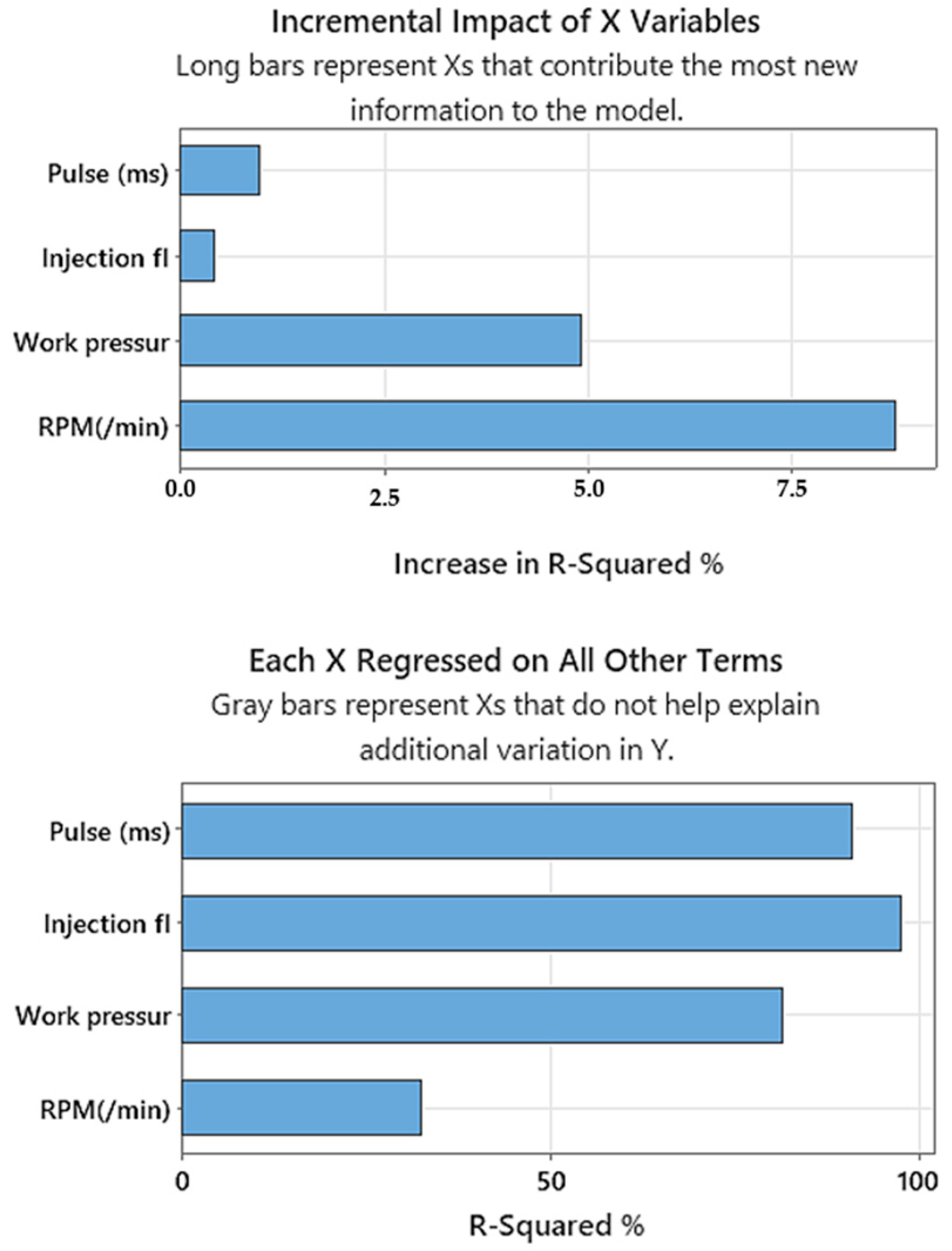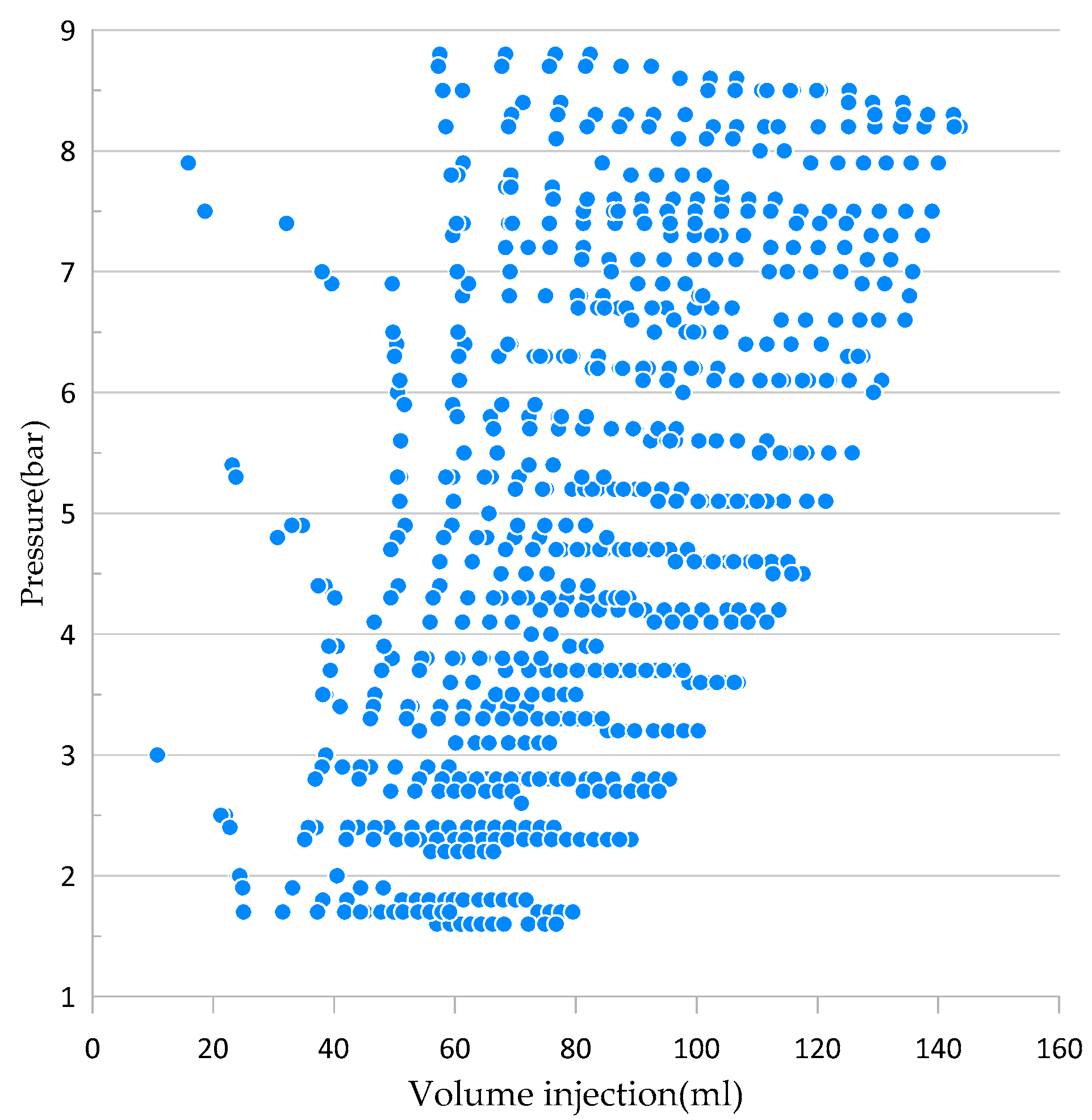Study of the Variation of Fuel Pressure to Improve Spraying and the Range of the Injection Jet
Abstract
:1. Introduction
2. Materials and Methods
2.1. Experimental Setup
2.1.1. Injector Bench
2.1.2. Injectors
2.1.3. Experimental Design
2.2. Method
Study Design
2.3. Experimental Conditions
2.3.1. Measurement Protocol
2.3.2. Data Logging
- In this case, each test is performed at a single speed, considering a range of variability of 750 min−1 as the initial range to 3000 min−1 as the final speed range.
- On the other hand, according to the technical reports visualized in the previous sections, in this test different operating pressures are applied concerning the injector, which consisted of increasing by 0.5 bar for each pressure and parameterizing a regime of 2 bar as a start and 9 bar as the final pressure value.
- Instead, the injection pulse is set in the already established data whose determination ranges from 0.8 ms to 5 ms in ranges of variability, with consecutive increases of 0.2 ms pulses as the test progressively increases.
3. Results
Mathematical Model with Suggested Statistical Basis
4. Discussion
5. Conclusions
6. Recommendations
Author Contributions
Funding
Acknowledgments
Conflicts of Interest
Nomenclature
| Stoichiometric dosage | |
| Relative dosage | |
| Intake pressure | |
| Operating Parameter | |
| Atmospheric parameter | |
| MPI | Multi-Point injection |
| SIE | Spark ignition engine |
References
- Cervera, L. Analysis of the Variation of Injection Pressure to Determine the Specific Fuel Consumption in 3000cc Common Rail Engines, Chiclayo; Cesar Vallejo University: Trujillo, Peru, 2018; Available online: https://hdl.handle.net/20.500.12692/28562 (accessed on 19 February 2023).
- Lv, G.; Song, C.L.; Pan, S.Z.; Gao, J.H.; Cao, X.F. Comparison of number, surface area and volume distributions of particles emitted from a multipoint port fuel injection car and a gasoline direct injection car. Atmos. Pollut. Res. 2014, 5, 753–758. [Google Scholar] [CrossRef] [Green Version]
- Tuan, N.T.; Dong, N.P. Improving performance and reducing emissions from a gasoline and liquefied petroleum gas bi-fuel system based on a motorcycle engine fuel injection system. Energy Sustain. Dev. 2022, 67, 93–101. [Google Scholar] [CrossRef]
- Pham, P.X.; Vo, D.Q.; Jazar, R.N. Development of fuel metering techniques for spark ignition engines. Fuel 2017, 206, 701–715. [Google Scholar] [CrossRef]
- Qu, L.; Wang, W.; Li, M.; Xu, X.; Shi, Z.; Mao, H.; Jin, T. Dependence of pollutant emission factors and fuel consumption on driving conditions and gasoline vehicle types. Atmos. Pollut. Res. 2021, 12, 137–146. [Google Scholar] [CrossRef]
- Erazo, G.; Mayorga, F.; Núñez, M. Diagnóstico y Mantenimiento de Inyectores de Sistemas de Inyección Directa de Gasolina GDI. Infociencia 2015, 9, 37–43. [Google Scholar]
- Huang, Y.; Surawski, N.C.; Zhuang, Y.; Zhou, J.L.; Hong, G. Dual injection: An effective and efficient technology to use renewable fuels in spark ignition engines. Renew. Sustain. Energy Rev. 2021, 143, 110921. [Google Scholar] [CrossRef]
- Mitukiewicz, G.; Dychto, R.; Leyko, J. Relationship between LPG fuel and gasoline injection duration for gasoline direct injection engines. Fuel 2015, 153, 526–534. [Google Scholar] [CrossRef]
- Shin, J.Y.; Lee, S.; Bae, C.; Jung, J.; Son, Y.; Heo, H.; Lee, J. Effect of late intake valve closing on the particle number emissions of a turbocharged gasoline direct injection engine. Fuel Process. Technol. 2022, 230, 107209. [Google Scholar] [CrossRef]
- Yuan, Y.; Zhao, M.; Yu, H.; Li, W.; Guo, B.; Zeng, Q.; Su, B. Estimation of combustion efficiency range and pressure fluctuation at low working condition. Energy Rep. 2022, 8, 169–178. [Google Scholar] [CrossRef]
- Ordoñez, I. Institutional Repository of the Salesian Polytechnic University: Interpretation of the Effects of the Pressure Drop of an Internal Combustion Engine Ignited by Compression CRDi Hyundai Santa Fé 2.0 through Noise Analysis; Salesian Polytechnic University: Cuenca, Ecuador, 2015; Available online: https://dspace.ups.edu.ec/handle/123456789/7944 (accessed on 19 February 2023).
- Feng, L.; Sun, X.; Pan, X.; Yi, W.; Cui, Y.; Wang, Y.; Wen, M.; Ming, Z.; Liu, H.; Yao, M. Gasoline spray characteristics using a high pressure common rail diesel injection system by the method of laser induced exciplex fluorescence. Fuel 2021, 302, 121174. [Google Scholar] [CrossRef]
- Pandey, R.K.; Rehman, A.; Sarviya, R.M. Impact of alternative fuel properties on fuel spray behavior and atomization. Renew. Sustain. Energy Rev. 2012, 16, 1762–1778. [Google Scholar] [CrossRef]
- Soo Yu, Y.; Yang, S.; Jeong, M.; Kim, H.; Yi, H.; Hwan Park, J.; Park, S. Experimental investigations on the spray structure and nozzle tip wetting using various fuels with an LPDI injector. Fuel 2022, 318, 123719. [Google Scholar] [CrossRef]
- Vera, C. Variation of the Pressure in the Combustion Chamber of an MCI with Respect to the Angular Position of the Crankshaft; Technological Institute of Pachuca: Pachuca, Mexico, 2015; Available online: http://www.itpachuca.edu.mx/pdf/repositorio_tesis/13200930.pdf (accessed on 19 February 2023).
- Al-lehaibi, M.; Liu, X.; Im, H.G. Numerical investigation of n-dodecane ECN spray and combustion characteristics using the one-way coupled Eulerian-Lagrangian approach. Fuel 2023, 331, 125759. [Google Scholar] [CrossRef]
- Syaka, D.R.; Margono, G.; Tyasmadi, A.T.; Dewantoro, T. Influence of duration and fuel injection pressure on two stroke gasoline direct injection engine performance. IOP Conf. Ser. Mater. Sci. Eng. 2021, 1098, 062090. [Google Scholar] [CrossRef]
- Sok, R.; Kusaka, J. Fuel-reforming effects on a gasoline direct injection engine under a low-temperature combustion mode: Experimental and kinetics analyses. Energy Convers. Manag. 2022, 255, 115304. [Google Scholar] [CrossRef]
- Qian, Y.; Li, Z.; Yu, L.; Wang, X.; Lu, X. Review of the state-of-the-art of particulate matter emissions from modern gasoline fueled engines. Appl. Energy 2019, 238, 1269–1298. [Google Scholar] [CrossRef]
- Liu, X.; Aljabri, H.; Al-lehaibi, M.; AlRamadan, A.S.; Badra, J.; Im, H.G. Numerical investigation of the effect of injection strategy on a high-pressure isobaric combustion engine. Int. J. Engine Res. 2021, 24, 595–609. [Google Scholar] [CrossRef]
- Ceper, B.A. Experimental investigation of the effect of spark plug gap on a hydrogen fueled SI engine. Int. J. Hydrogen Energy 2012, 37, 17310–17320. [Google Scholar] [CrossRef]
- Zibani, I.; Marumo, R.; Chuma, J.; Ngebani, I.; Tsamaase, K. Stepping Valve Actuator Algorithm for a Camless IC Engine. Procedia Manuf. 2019, 33, 99–106. [Google Scholar] [CrossRef]
- Wittek, K.; Geiger, F.; Andert, J.; Martins, M.; Cogo, V.; Lanzanova, T. Experimental investigation of a variable compression ratio system applied to a gasoline passenger car engine. Energy Convers. Manag. 2019, 183, 753–763. [Google Scholar] [CrossRef]
- Gao, J.; Tian, G.; Sorniotti, A.; Karci, A.E.; Di Palo, R. Review of thermal management of catalytic converters to decrease engine emissions during cold start and warm up. Appl. Therm. Eng. 2019, 147, 177–187. [Google Scholar] [CrossRef]
- Sun, P.; Liu, Z.; Yu, X.; Yao, C.; Guo, Z.; Yang, S. Experimental study on heat and exergy balance of a dual-fuel combined injection engine with hydrogen and gasoline. Int. J. Hydrogen Energy 2019, 44, 22301–22315. [Google Scholar] [CrossRef]
- Guo, H.; Li, Y.; Lu, X.; Zhou, Z.; Xu, H.; Wang, Z. Radial expansion of flash boiling jet and its relationship with spray collapse in gasoline direct injection engine. Appl. Therm. Eng. 2019, 146, 515–525. [Google Scholar] [CrossRef]
- Schrödinger, C.; Oevermann, M.; Krüger, O.; Lacarelle, A.; Paschereit, C.O. CFD Modeling of the Influence of Fuel Staging on the Mixing Quality and Flame Characteristics in a Lean Premixed Combustor. Proc. ASME Turbo Expo 2010, 2, 777–789. [Google Scholar] [CrossRef]
- NTE INEN OIML R 117-1. Dynamic Measurement Systems for Liquids Other than Water. Part 1: Metrological and Technical Requirements. Available online: https://www.normalizacion.gob.ec/buzon/normas23/nte_inen-oiml_r_117-1.pdf (accessed on 19 February 2023).
- Backes, F.; Blochum, S.; Härtl, M.; Wachtmeister, G. Experimental Analysis of Gasoline Direct Injector Tip Wetting. SAE Int. J. Engines 2019, 13, 77–91. [Google Scholar] [CrossRef]
- Muro, X.; de Nava, M.L.; González R., M.E.; de Giménez, F.T.; Becerra, O.; de Moya, R.D.; Calzadilla, O.; Aranan, A.; de Osorio, L.S.; Quintero, C.R. Towards A Definition of The Quality of Research at the Libertador Experimental Pedagogical University. Investig. Postgrado 2003, 18, 23–35. Available online: http://ve.scielo.org/scielo.php?script=sci_arttext&pid=S1316-00872003000100005&lng=es&nrm=iso&tlng=es (accessed on 19 February 2023).
- Yu, X.; Zhao, Z.; Huang, Y.; Shi, W.; Guo, Z.; Li, Z.; Du, Y.; Jin, Z.; Li, D.; Wang, T.; et al. Experimental study on the effects of EGR on combustion and emission of an SI engine with gasoline port injection plus ethanol direct injection. Fuel 2021, 305, 121421. [Google Scholar] [CrossRef]
- Chincholkar, S.P.; Suryawanshi, J.G. Gasoline Direct Injection: An Efficient Technology. Energy Procedia 2016, 90, 666–672. [Google Scholar] [CrossRef]
- Payri, F.; Desantes, J.M. Motores de Combustión Interna Alternativos, 5th ed.; Reverté: Barcelona, Spain, 2011; Available online: www.reverte.com (accessed on 19 February 2023).
- Aguera Soriano, J. Termodinámica Lógica y Motores TérmicosSexta.; Ciencia 3. 1999. Available online: https://www.casadellibro.com/libro-termodinamica-logica-y-motores-termicos-6-ed/9788486204983/803637 (accessed on 19 February 2023).
- Payri, R.; García, A.; Domenech, V.; Durrett, R.; Plazas, A.H. An experimental study of gasoline effects on injection rate, momentum flux and spray characteristics using a common rail diesel injection system. Fuel 2012, 97, 390–399. [Google Scholar] [CrossRef] [Green Version]













| Characteristics GT-600-PRO | |
|---|---|
| Work control pressure | Microprocessor Controlled |
| Test tubes | 6 |
| Resistance control (ohm) | Low ohms |
| Weight (Kg) | 32 |
| Speed variation (min−1) | 10–9990 |
| Pulse width (ms) | 0.5–25 |
| Tank capacity (L) | 3 |
| High-pressure pump (bar) | 0–10 |
| Working voltage (V) | 120 V |
| Ultrasound tub power | 100 W hammer |
| Working frequency (Hz) | 50/60 |
| Characteristics | Numerical Specifications |
|---|---|
| Type of injector | Solenoid |
| Number of holes | 4 |
| Hole diameter | 150 µm |
| Work pressure | 3.5 to 5 bar |
| Injection angle | 12° |
| Spray angle | 7.88 to 14.39° |
| Mark | Hyundai 35310-25200 |
| Resistance | 1.331 KΩ |
| Tests | Current Consumption (mA) |
|---|---|
| Low speed | 0 to 16.61 mA |
| Average speed | 35.19 to 35.39 mA |
| High Speed | 86.1 to 90.3 mA |
| Revolutions per Minute (min−1) | 660 | 2000 | 4000 |
|---|---|---|---|
| CO (%) | 0.32 | 0.67 | 0.17 |
| Lambda | 1.11 | 1.05 | 1.06 |
| CO2 (%) | 13.7 | 14.8 | 15.1 |
| CO corrected (%) | 0.35 | 0.72 | 0.17 |
| HC (ppm) | 159 | 172 | 81 |
| O2 (%) | 2.84 | 1.20 | 1.43 |
| Pressure (Bar) | Pulse (ms) | Flow Rate (mL) | Average Volume Rate (mL) | Working Pressure (Bar) | Injection Angle (°) | Spray Angle (°) | |||
|---|---|---|---|---|---|---|---|---|---|
| Test Injector 1 | Test Injector 2 | Test Injector 3 | Test Injector 4 | ||||||
| 3.5 | 0.8 | 0 | 0 | 0 | 0 | 0 | 0 | 0 | 0 |
| 3.5 | 1 | 0 | 0 | 0 | 0 | 0 | 3.5 | 0 | 0 |
| 3.5 | 1.2 | 0 | 0 | 0 | 0 | 0 | 3.5 | 0 | 0 |
| 3.5 | 1.4 | 38.5 | 38.5 | 40 | 35.5 | 38.13 | 3.5 | 11.92 | 6.91 |
| 3.5 | 1.6 | 46 | 46.5 | 48 | 43.5 | 46 | 3.3 | 11.92 | 7.15 |
| 3.5 | 1.8 | 52 | 52 | 54.5 | 49.5 | 52 | 3.3 | 11.92 | 7.62 |
| 3.5 | 2 | 56.5 | 56.5 | 59 | 44.5 | 54.13 | 3.2 | 11.92 | 7.69 |
| 3.5 | 2.2 | 60.5 | 60 | 62.5 | 57.5 | 60.13 | 3.1 | 11.92 | 8.25 |
| 3.5 | 2.4 | 63.5 | 63 | 66 | 61 | 63.38 | 3.1 | 11.92 | 8.45 |
| 3.5 | 2.6 | 66 | 66 | 66.5 | 64 | 65.63 | 3.1 | 11.92 | 8.81 |
| 3.5 | 2.8 | 69 | 68.5 | 71.5 | 66.5 | 68.88 | 3.1 | 11.92 | 9.1 |
| 3.5 | 3 | 72 | 71 | 74 | 69.5 | 71.63 | 3.1 | 11.92 | 9.67 |
| 3.5 | 3.2 | 74 | 73.5 | 76.5 | 71.5 | 73.88 | 3.1 | 11.92 | 9.71 |
| 3.5 | 3.4 | 76 | 75 | 78 | 73.5 | 75.63 | 3.1 | 11.92 | 10.48 |
| 3.5 | 3.6 | 76 | 75 | 78 | 73.5 | 75.63 | 3.1 | 11.92 | 10.48 |
| 3.5 | 3.8 | 76 | 75 | 78 | 73.5 | 75.63 | 3.1 | 11.92 | 10.48 |
| 3.5 | 4 | 76 | 75 | 78 | 73.5 | 75.63 | 3.1 | 11.92 | 10.48 |
| 3.5 | 4.2 | 76 | 75 | 78 | 73.5 | 75.63 | 3.1 | 11.92 | 10.48 |
| 3.5 | 4.4 | 76 | 75 | 78 | 73.5 | 75.63 | 3.1 | 11.92 | 10.48 |
| 3.5 | 4.6 | 76 | 75 | 78 | 73.5 | 75.63 | 3.1 | 11.92 | 10.48 |
| 3.5 | 4.8 | 76 | 75 | 78 | 73.5 | 75.63 | 3.1 | 11.92 | 10.48 |
| 3.5 | 5 | 76 | 75 | 78 | 73.5 | 75.63 | 3.1 | 11.92 | 10.48 |
| Variable | Unit of Measurement | Symbology |
|---|---|---|
| Volume injection | mL | Q |
| Revolution per minute | min−1 | X1 |
| Pulse | ms | X2 |
| Work pressure | bar | X3 |
| Spray angle | ° | X4 |
| min−1 (RPM) | Flow Injection (mL) |
|---|---|
| 750 | 63 |
| 1500 | 66.5 |
| 3000 | 62.5 |
| min−1 (RPM) | Flow Injection (mL) |
|---|---|
| 750 | 102.5 |
| 1500 | 103 |
| 3000 | 78 |
| min−1 (RPM) | Flow Injection (mL) |
|---|---|
| 750 | 67 |
| 1500 | 66.5 |
| 3000 | 66 |
| Obtained Value | Calculated Value | Percent General | Percent Obtained |
|---|---|---|---|
| 68,375 mL | 68.422774 mL | 100 ± 2% | 100.08% |
| Fuel Pressure | CO | CO2 | HC | O2 | Lambda | Min−1 |
|---|---|---|---|---|---|---|
| 6 bar | 0.01 | 14 | 70 | 0.11 | 1.004 | 760 |
| 0.01 | 14.1 | 140 | 0.06 | 1.002 | 2000 | |
| 0.01 | 14 | 110 | 0.09 | 1 | 3000 | |
| 5 bar | 0 | 14.1 | 90 | 0.08 | 1.003 | 810 |
| 0.01 | 14.1 | 110 | 0.04 | 1.003 | 2000 | |
| 0.03 | 14.1 | 90 | 0.01 | 1 | 3000 | |
| 4.5 bar | 0.06 | 13.8 | 112 | 0.33 | 1.012 | 760 |
| 0.03 | 14.1 | 110 | 0.09 | 1.002 | 2080 | |
| 0.01 | 13.9 | 100 | 0.04 | 1.002 | 3020 | |
| 4 bar | 0 | 14.1 | 190 | 0.11 | 1.004 | 760 |
| 0.01 | 14.1 | 270 | 0.08 | 1.005 | 2000 | |
| 0.25 | 14 | 150 | 0.01 | 0.998 | 3010 | |
| Idle | 0.01 | 13.9 | 630–150 | 0.02 | 1.007 | 760 |
| 0.01 | 14 | 150 | 0.04 | 1.001 | 2000 | |
| 0.19 | 13.8 | 100 | 0.02 | 1.001 | 3000 |
Disclaimer/Publisher’s Note: The statements, opinions and data contained in all publications are solely those of the individual author(s) and contributor(s) and not of MDPI and/or the editor(s). MDPI and/or the editor(s) disclaim responsibility for any injury to people or property resulting from any ideas, methods, instructions or products referred to in the content. |
© 2023 by the authors. Licensee MDPI, Basel, Switzerland. This article is an open access article distributed under the terms and conditions of the Creative Commons Attribution (CC BY) license (https://creativecommons.org/licenses/by/4.0/).
Share and Cite
Rojas-Reinoso, V.; Duque-Escobar, S.; Guapulema-Guapulema, C.; Soriano, J.A. Study of the Variation of Fuel Pressure to Improve Spraying and the Range of the Injection Jet. Energies 2023, 16, 5472. https://doi.org/10.3390/en16145472
Rojas-Reinoso V, Duque-Escobar S, Guapulema-Guapulema C, Soriano JA. Study of the Variation of Fuel Pressure to Improve Spraying and the Range of the Injection Jet. Energies. 2023; 16(14):5472. https://doi.org/10.3390/en16145472
Chicago/Turabian StyleRojas-Reinoso, Vicente, Stalin Duque-Escobar, Christian Guapulema-Guapulema, and José Antonio Soriano. 2023. "Study of the Variation of Fuel Pressure to Improve Spraying and the Range of the Injection Jet" Energies 16, no. 14: 5472. https://doi.org/10.3390/en16145472
APA StyleRojas-Reinoso, V., Duque-Escobar, S., Guapulema-Guapulema, C., & Soriano, J. A. (2023). Study of the Variation of Fuel Pressure to Improve Spraying and the Range of the Injection Jet. Energies, 16(14), 5472. https://doi.org/10.3390/en16145472








